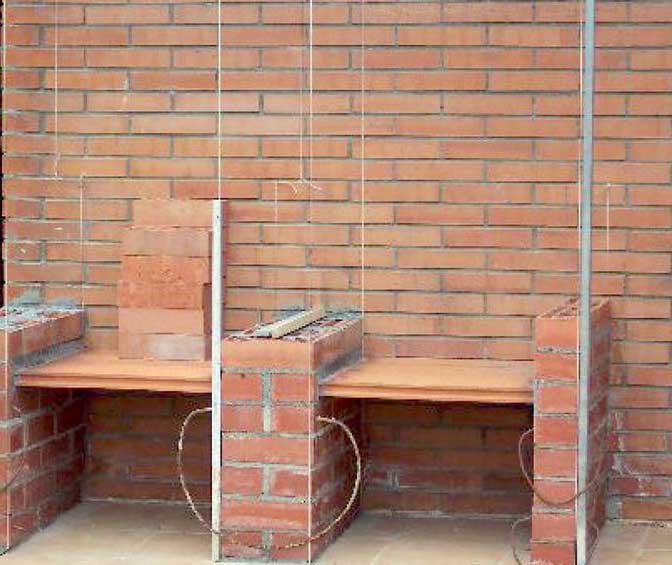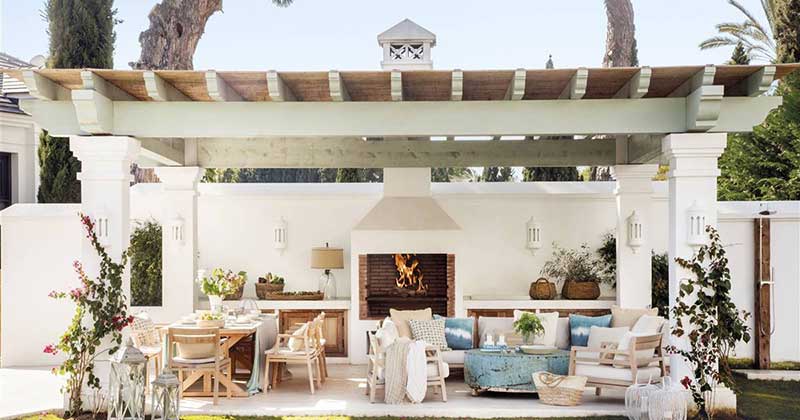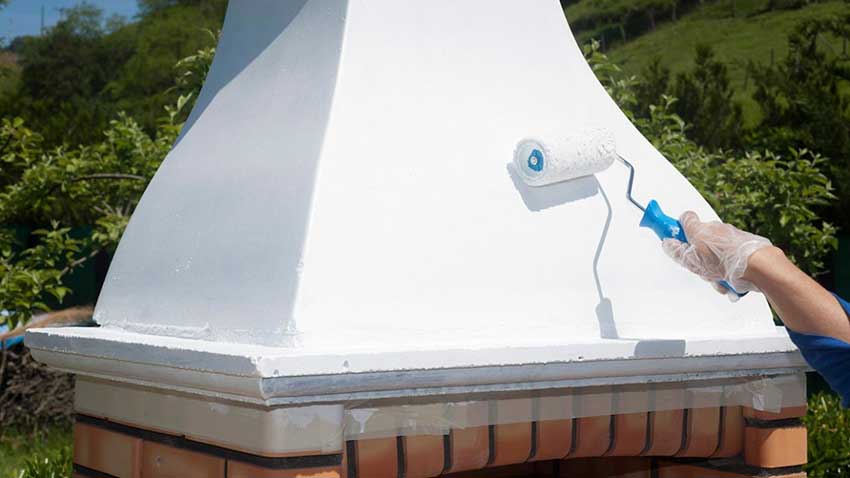
Barbecue with hood
Barbecue with hood: These channel the air better, which helps to create better combustion and the conduction of smoke. In addition, the sparks that may be generated can be better controlled. They turn out to be quite practical, since the smoke does not go directly to the face. On the other hand, these tend to be more aesthetically beautiful and with more defined finishes.

Barbecue without hood
Barbecue without hood: It helps to have a better view of the food that is being cooked, as there are no barriers that prevent the view of what is being cooked. This helps you cook your dishes better. However, the smoke goes straight into your face, which can be annoying.

Types of construction barbecues
The great advantage of mobile barbecues is that you can change places whenever you want, until you find the most suitable one. But it will not be the case with a built-in barbecue. So in this case you will have to think a lot about where you are going to install it.
You should avoid at all costs that it is near doors or windows. If it is a barbecue with a hood, which helps send the fumes skyward, there will be no problem. But what if you buy one without a hood? All fumes can end up inside the house and it is very annoying.
Homemade barbecue
Nor should it be installed near the area where your guests eat. It is true that it is pleasant to receive the smell of food on the barbecue, but not the smoke. Also avoid being near a pool area. The floor of the barbecue area should be tile, to avoid that if a sparks jump it can cause a fire.

I want to paint my barbecue, is it difficult?
It is not necessary to be cleaning the barbecue every two by three. In fact, with annual maintenance you can have a kitchen companion for life. Now, it is recommended that you do at least a little maintenance.
In order to clean it, you have to use coffee grounds, oil and newspaper. With the help of a brush, remove all the ashes from the barbecue. Now clean that area, put newspaper papers. Using the coffee grounds, rub the newspapers and the grill, which will be able to eliminate the fat that is encrusted. The remains will remain on the newspaper.
Finally, using the oil, you have to go over each of the bars on the grill. This will help keep them from rusting. A process that will take you only half an hour and you will have it shiny, as if it were new.
It's easy, cheer up and surprise your family and friends
- Gloves
- Glue gun
- Palettes
- Drawer
- Cement
- Sand
- Putty (that withstands high temperatures)
Assemble a construction barbecue step by step:
- Once you have chosen a level and rigid place (it should not be loose or very soft earth) you must place the base of the barbecue with a strip. Fix the pieces to the ground using the putty.
- Next, the sink part, the work area and the grill part must be assembled. Putty is the best to fix it, but you must also join each piece with a little cement to guarantee its resistance.
- Waiting for the structure to dry a little, place the grill (remember that it must be adapted to the shape of your grill).
- The chimney, hood, drain and fans remain to be installed. Some models may not have a hood or fans, it all depends on the money you have decided to spend on your construction barbecue.
In the market you have many options, some prefabricated ones are sold that usually come with the instructions, but if you like DIY you can buy the materials in any DIY store and assemble it yourself, you have a lot of information on the internet and also many videos that explain everything Step by Step. Cheer up and surprise your friends and family!
Refractory brick is a ceramic material that has a series of special characteristics, which allows it to be used widely in industrial facilities or in domestic stove work. The faces of these bricks are smooth. This peculiar characteristic reduces the adherence with the mortar, achieving resistance to high temperatures and abrasion. Due to its good thermal properties this material is considerably expensive.
Description:
Refractory bricks are currently used to line boilers, steel pots, grills, cement plant rotary kilns, to name a few, where these must be adhered to one another with refractory earth and to improve the firmness of the bond, cement can also be added. ; resulting in a mixture that will have a muddy appearance; This mixture allows the bond to be strong enough for the processes.
The handling of these bricks is not as simple as handling ordinary bricks, because due to their same properties they react explosively with other materials than the correct ones.
Like refractory earth, refractory bricks, in addition to fulfilling their function of refraction, are excellent heat containers, that is, they maintain the heat to which they are exposed during their different uses.
One of the peculiarities of this type of material is that they are manufactured in varied qualities, depending on the concentration of alumina and based on this concentration, the brick resists higher temperatures or can be used for different media. Concentrations range from 36% to 99% alumina although silica can also be used.
Mainly when you want to cover furnaces intended for smelting steel, the type of brick used is silicon dioxide, in some cases when the bricks begin to liquefy they work at temperatures above 3000 ° F (1650 ° C).
In order to create these bricks it is necessary that their components are exposed to low pressures and that they are in turn fired at very high temperatures. The exceptions to this process are those bricks that are chemically bonded, or those that use tar, resin or rubber to remain bonded.
Properties by content
The refractory bricks used are of two types depending on the content of clay with silicas or aluminas; also for its magnesite content and other components. The properties of these compounds allow the brick to withstand high temperatures. Although the behavior of each one is very specific to the material.
Refractory Bricks with High Alumina Content
The coefficient of thermal expansion of this type of brick is very low. Thanks to this property, the bricks are prepared to withstand high temperatures, without presenting any type of deformation or expansion that modifies the performance of the brick after cooling.
As the clay required for their manufacture is very little, and the content of alumina (an expensive material) is high, the market price of these bricks is high.
High Silica Content Refractory Bricks
Like the previous ones, these bricks are designed to be exposed to high temperatures, however, when they are subjected to alternative or continuous phases from heat to cold, they tend to expand considerably for industrial use. And these continuous changes in temperature, as well as in shape, affect the brick in such a way that it ends up disintegrating. This type of brick is very useful in areas where the temperatures to which it is exposed are continuously high.